The AMD Radeon R9 380X Review, Feat. ASUS STRIX
by Ryan Smith on November 23, 2015 8:30 AM EST- Posted in
- GPUs
- AMD
- Radeon
- Asus
- Radeon 300
Power, Temperature, & Noise
As always, last but not least is our look at power, temperature, and noise. Next to price and performance of course, these are some of the most important aspects of a GPU, due in large part to the impact of noise. All things considered, a loud card is undesirable unless there’s a sufficiently good reason – or sufficiently good performance – to ignore the noise.
Unfortunately we don’t have any tools that can read the GPU voltage on the ASUS card, so we’ll jump right into average clockspeeds.
| Radeon R9 380X Average Clockspees | |||
| Game | ASUS R9 380X (OC) | ASUS R9 380X (Ref) | |
| Max Boost Clock | 1030MHz | 970MHz | |
| Battlefield 4 |
1030MHz
|
970MHz
|
|
| Crysis 3 |
1030MHz
|
970MHz
|
|
| Mordor |
1030MHz
|
970MHz
|
|
| Dragon Age |
1030MHz
|
970MHz
|
|
| Talos Principle |
1030MHz
|
970MHz
|
|
| Total War: Attila |
1030MHz
|
970MHz
|
|
| GRID Autosport |
1030MHz
|
970MHz
|
|
| Grand Theft Auto V |
1030MHz
|
970MHz
|
|
The ASUS R9 380X has no problem holding its full boost clockspeed in games, both at its stock speed of 1030MHz and when downclocked to 970MHz.
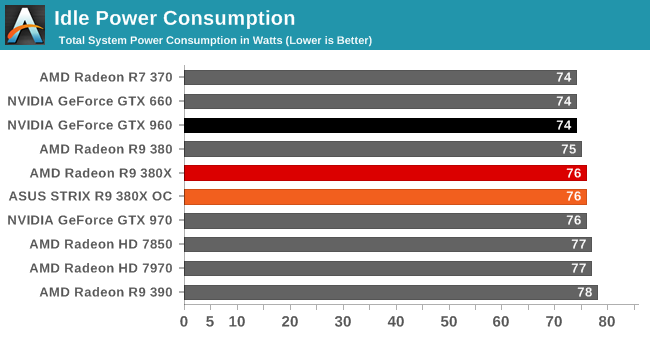
Starting with idle power consumption, the ASUS card comes in right where we’d expect it. 75-76W is typical for a Tonga card on our GPU testbed.

Moving on to power consumption under Crysis 3, like so many other aspects of R9 380X, its performance here is very close to the original R9 380. Power consumption is up slightly thanks to the additional CUs and the additional CPU load from the higher framerate, with the reference clocked R9 380X coming in at 299W, while ASUS’s factory overclock pushes that to 304W.
The problem for AMD is that this is smack-dab in GTX 970 territory. Meanwhile the GTX 960, though slightly slower, is drawing 74W less at the wall. R9 380 just wasn’t very competitive on power consumption compared to Maxwell, and R9 380X doesn’t do anything to change this. AMD’s power draw under games is essentially one class worse than NVIDIA’s – the R9 380X draws power like a GTX 970, but delivers performance only slightly ahead of a GTX 960.
The one bit of good news here for AMD is that while the power consumption of the R9 380X isn’t great, it’s still better balanced than the R9 390. With AMD opting to push the envelope there to maintain price/performance parity with the GTX 970, while the R9 380X is a fair bit slower than the R9 390, it saves a lot of power in the process. And for that matter the R9 380X shows a slight edge over the 7970, delivering similar gaming performance for around 16W less at the wall.
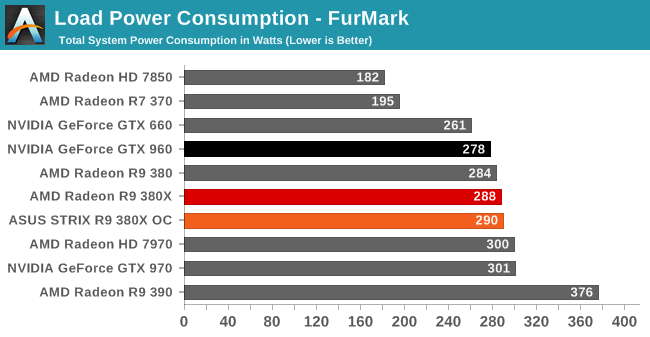
Moving over to FurMark our results get compressed by quite a bit (we’re using a GTX 960 with a fairly high power limit), but even then the R9 380X’s power consumption isn’t in AMD’s favor. At best we can say it’s between the GTX 960 and GTX 970, with the former offering performance not too far off for less power.
Otherwise as was the case with Crysis 3, the R9 380X holds a slight edge over the 7970 on power consumption. This despite the fact that the R9 380X uses AMD’s newer throttling technology, and consequently it gets closer to its true board limit than the 7970 ever did.
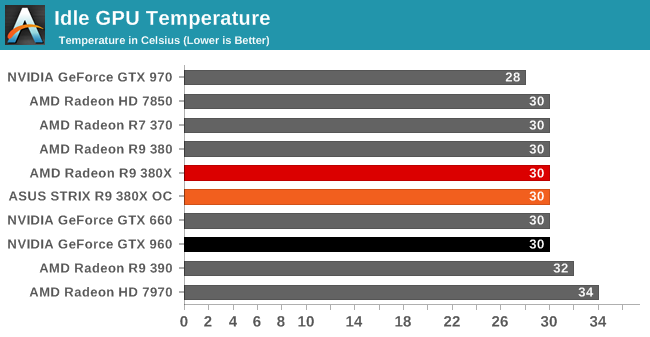
With idle temperatures ASUS’s 0db Fan technology doesn’t hamper the R9 380X at all. Even without any direct fan airflow the STRIX R9 380X holds at 30C.
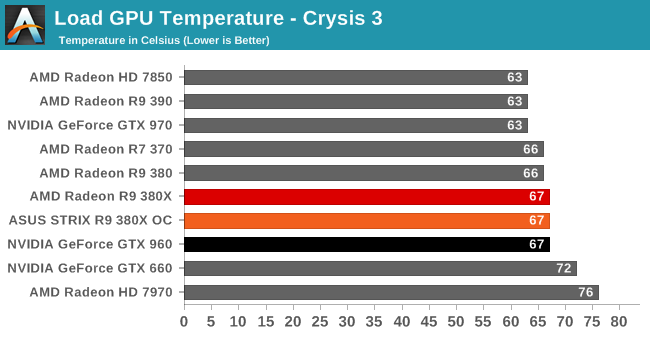
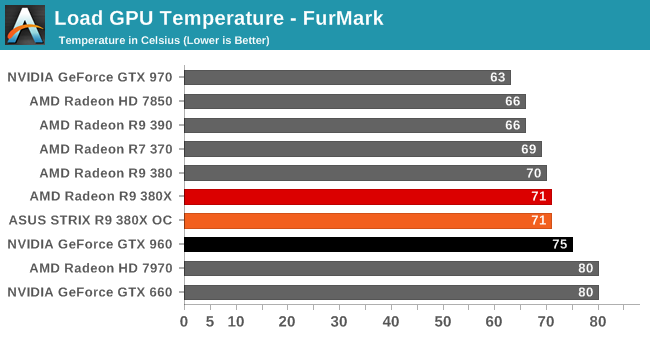
Load temperatures also look good. ASUS’s sweet spot seems to be around 70C – right where we like to see it for an open air cooled card – with the R9 380X reaching equilibrium at 67C for Crysis 3 and 71C for FurMark.
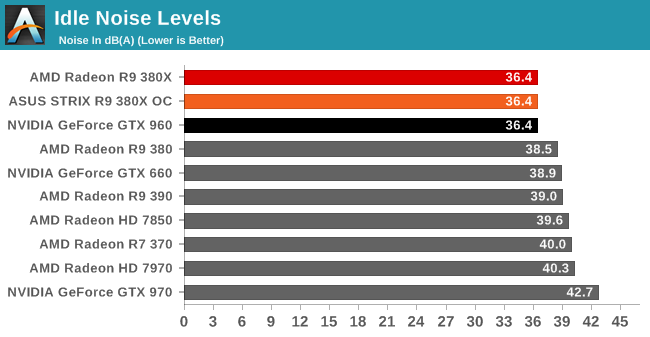
Finally with idle noise, the zero fan speed idle technology on the STRIX lineup means that the STRIX R9 380X gets top marks here. At 36.4dB the only noise coming from our system is closed loop liquid cooler for the CPU. The video card is completely silent.
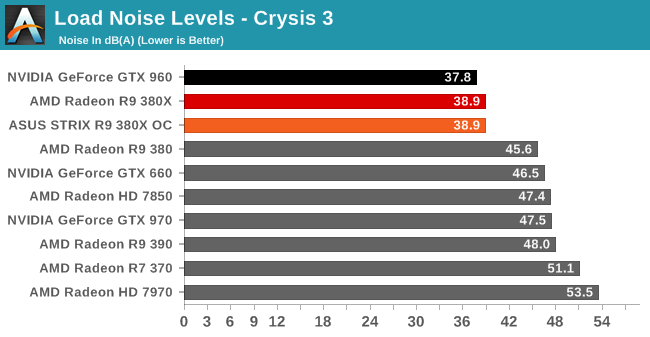
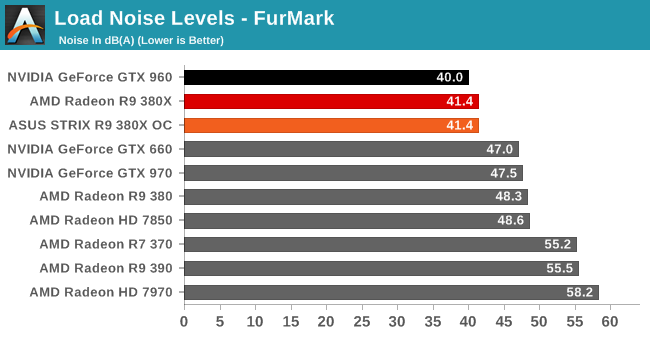
Shifting over to load noise levels then, the STRIX R9 380X continues to impress. With Crysis 3 the card tops out at 38.9dB – less then 3dB off of our noise floor – and that goes for both when the card is operating at AMD’s reference clocks and ASUS’s factory overclock. At this point the STRIX R9 380X is next-to-silent; it would be hard to do too much better without using an entirely passive cooling setup. So for ASUS to dissipate what we estimate to be 175W or so of heat while making this little noise is nothing short of impressive.
Meanwhile with FurMark the ASUS card needs to work a bit harder, but it still offers very good results. Even with the card maxed out we’re looking at just 41.4dB. The STRIX R9 380X isn’t silent, but it gets surprisingly close for such a powerful card.










101 Comments
View All Comments
godrilla - Monday, November 23, 2015 - link
Newegg has the PowerColor r9 390 for $265.99 preblackfriday deal, for a bit more you get 20% more performance and double the vram!r3loaded - Tuesday, November 24, 2015 - link
Good to see my 7970 is still holding up very well even after almost four years!Enterprise24 - Tuesday, November 24, 2015 - link
7970 from 2011 can still compete with 380X in 2015.CiccioB - Tuesday, November 24, 2015 - link
Even the GTX480 can compete with GTX750Ti... something to be proud of, isn't it?evilspoons - Tuesday, November 24, 2015 - link
Ah, I'm still undecided what to do with respect to replacing my SLI GTX 680s. I'm in Canada so we're getting murdered by the exchange rate (GTX 970 is $380-$450, R9 390 is $450, the first R9 380X cards are $330...).Guess I'll just hold on to my 680s a while longer.
Mugur - Wednesday, November 25, 2015 - link
I don't think that 380x is a bad card, by any means. It just needs to replace 380 4GB in that price slot and/or the OEMs to bin 380 with only 2 GB of RAM and let the 4G only for 380x. Currently, although understandable for the "novelty" factor, I saw in my country the Asus 380x Strix OC with the same price that some (discounted or not) GTX 970 or R9 390 cards (including an Asus Strix 970 OC :-) ) which is hilarious. Also with like 50% more than a Sapphire Nitro 380 4GB that I bought on Black Friday. Or AMD could simply replace 380 with 380x if the yields are good enough...SolMiester - Wednesday, November 25, 2015 - link
LOL, bit late to the party isnt it, anyone buying mid range has probably already purchased this generation...aria - Monday, November 30, 2015 - link
I'm not sure I agree. I'm still rocking an HD 7750 (perhaps "wheeling," as in "wheelchair" might be more appropriate at this point). It was mid-tier when I got it, but now it's not really sufficient. I'd like to play games at 1920x1080, but i don't really care; 1360x768 is good enough for me. But my current card can't even deliver that at 60 fps any longer (I actually think the card has deteriorated, because I played Dragon Age Inquisition last year on decent settings, and now I can't run it at 15 fps on Low and 1024x768). Anyway, most people using mid-tier I imagine are more like me. We don't purchase an upgrade as soon as one is available--we want to get the highest mid-tier we can, which involves waiting. If I'd replaced my 7750 two months ago, today I would have an inferior mid-tier card, which certainly will become important a year from now when I'm trying to get just a bit more performance out of it. 10% doesn't matter today, but 18 months from now that 10% will mean the difference between playable and unplayable. The rules of high end gaming aren't applicable at the mid-tier range, because we don't buy an upgrade simply because it's an upgrade.HollyDOL - Thursday, November 26, 2015 - link
Another proof graphics industry badly needs new manufacturing process. Possibilities of what can be achieved at 28nm (GPU wise) seem to be exhausted. It will get interesting with new process + HBM2, until then it's going to be a stall water.lazymangaka - Tuesday, December 1, 2015 - link
Unless someone was able to snag the 380X at a significant discount, I would have trouble justifying not spending the extra money to jump to the 390. That really looks like it would be $60 well spent.